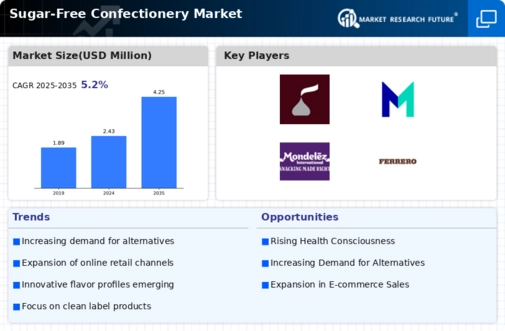Top Industry Leaders in the Sugar-Free Confectionery Market

The Competitive Landscape of the Sugar-Free Confectionery Market is shaped by key players responding to the increasing consumer demand for healthier alternatives in the confectionery sector. Both established manufacturers and emerging companies are implementing various strategies to tap into the growing market for sugar-free and low-calorie confectionery products.
Key Players:
THE HERSHEY COMPANY
Nestlé
Mars Incorporated
Mondelez International
Chocoladefabriken Lindt & Sprüngli AG
Ferrero
HARIBO of America Inc.
Strategies Adopted:
The Sugar-Free Confectionery Market revolve around product innovation, marketing, and partnerships. Product innovation is a crucial strategy, involving the development of new and improved sugar-free formulations that maintain the taste and texture expected by consumers. Marketing strategies often focus on highlighting the health benefits of sugar-free options, appealing to consumers looking to reduce their sugar intake. Partnerships with retailers, health food stores, and online platforms contribute to expanding market reach and increasing product visibility.
Market Share Analysis:
The Sugar-Free Confectionery Market is influenced by factors such as brand recognition, distribution channels, pricing, and consumer loyalty. Well-established brands with a history of consumer trust often secure larger market shares, leveraging their reputation to introduce and promote sugar-free variants. Effective distribution networks, including partnerships with grocery chains and convenience stores, play a crucial role in ensuring product accessibility. Competitive pricing strategies, balancing affordability with perceived product value, are essential for attracting a broad customer base. Adherence to quality standards, such as clean-label ingredients and nutritional transparency, contributes to building consumer loyalty and market share.
New & Emerging Companies:
The Sugar-Free Confectionery Market contribute to the competitive landscape by focusing on niche markets, unique formulations, and addressing specific dietary preferences. Start-ups and health-focused confectionery brands, such as Lily's Sweets and SmartSweets, have gained traction by offering innovative sugar-free and low-sugar options. While these companies may have relatively smaller market shares compared to industry giants, their agility, commitment to healthier alternatives, and emphasis on transparency contribute to the overall dynamism of the market.
Industry Trends:
Industry trends provide insights into ongoing developments within the Sugar-Free Confectionery Market. A notable trend in 2023 is the increased investment in research and development to enhance the taste and texture of sugar-free confectionery products. Key players are actively exploring technologies and alternative sweeteners to create sugar-free options that closely mimic the experience of traditional confectionery. Investments in marketing campaigns that educate consumers about the taste and health benefits of sugar-free alternatives reflect the industry's commitment to meeting evolving consumer preferences.
Competitive Scenario:
The Sugar-Free Confectionery Market remains dynamic, with companies adapting diverse strategies to stay competitive in this rapidly evolving industry. Collaborations with health and wellness influencers, dietitians, and fitness experts contribute to understanding market trends and aligning sugar-free confectionery offerings with evolving consumer needs. Digitalization of marketing and communication channels is becoming essential for companies to engage with consumers directly, gather feedback, and adapt to changing preferences.
Recent Development
The Sugar-Free Confectionery Market is the increased focus on sustainable packaging. Key players are responding to consumer concerns about environmental impact by investing in eco-friendly packaging for their sugar-free confectionery products. This development aligns with the broader industry trend towards sustainability and corporate responsibility, addressing the growing demand for products that consider both health and environmental considerations.


